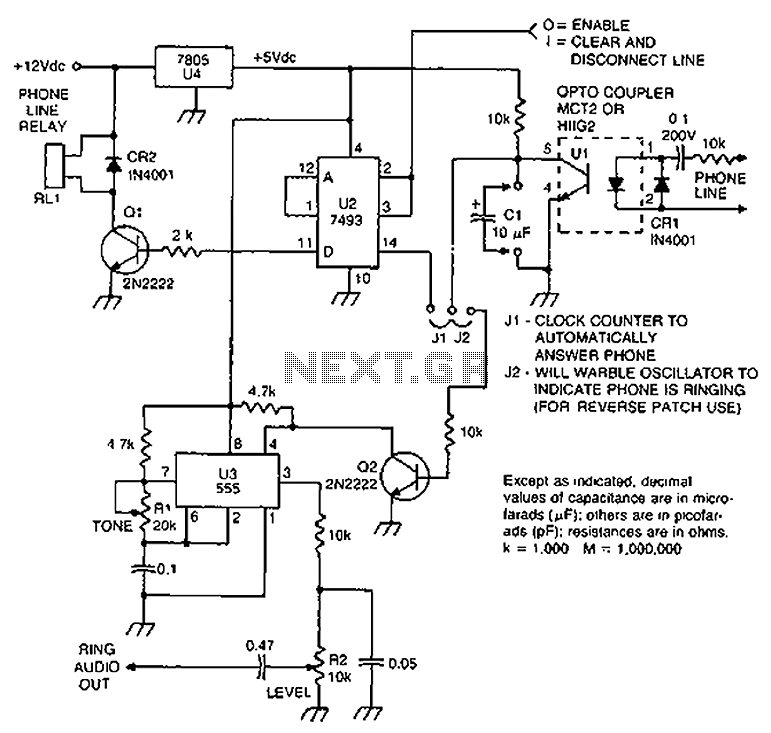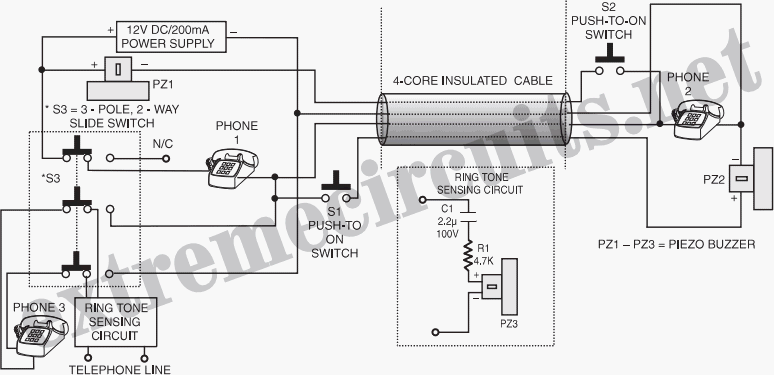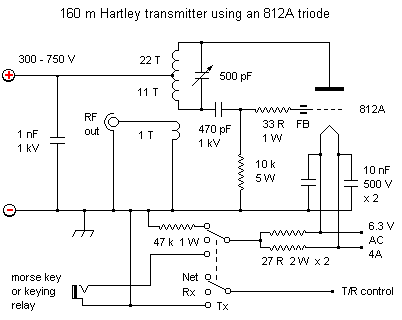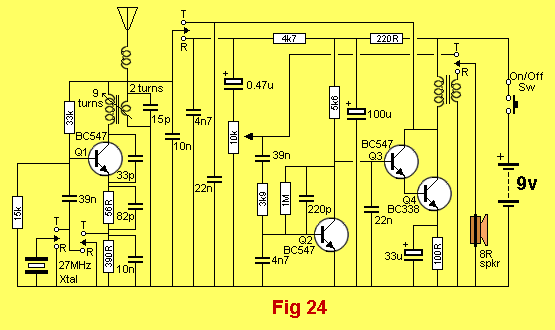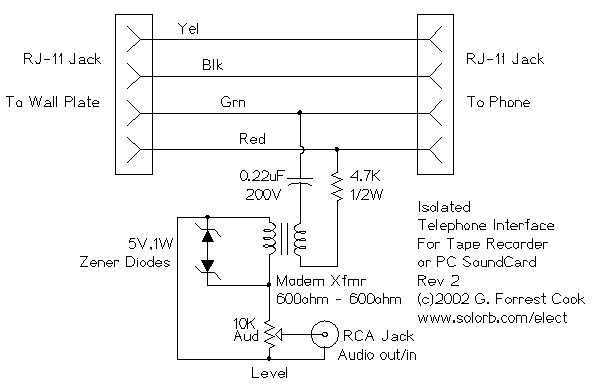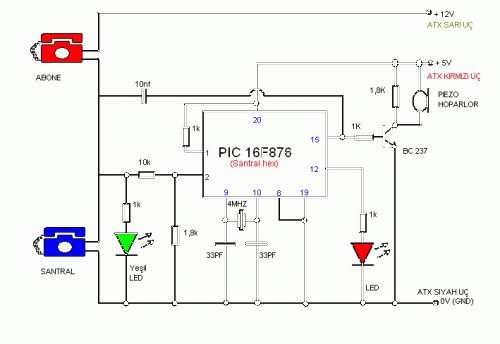
telephone ringer project
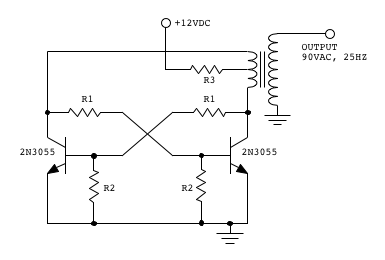
Make two telephones ring on stage. This involves sending a signal down a line to the phones. An old telephone exchange system was initially sought but not found. Several circuit ideas have been discovered, but the goal is to create a realistic ringer output of approximately 70-80 volts at 25 Hz. There is uncertainty about the best method to create a basic analog frequency divider. It was noted that subcycle transformers were used to generate 30 Hz from a 60 Hz power line, utilizing an LC tuned winding of a transformer. Using the power line frequency may be simpler. Frequency-selective ringers for party lines operate between 20 Hz and 60 Hz. Regardless of the frequency used with the old two-bell ringers, the tone remains consistent, making it difficult to distinguish between a bell ringing at 60 Hz and one at 20 Hz. The ringer operates strictly on AC and is isolated from the 48-volt DC talk battery by a 0.1 µF, 200-volt capacitor in the telephone's network. Unlike an MP3 file, a proper phone ring does not cut off abruptly; there is a distinct "ding" from the handset as it concludes ringing, creating an echo effect. This echo is often missing in digital renditions. The US ringing cycle consists of 2 seconds on and 4 seconds off, while the ringback tone that the calling party hears is 1 second on and 3 seconds off. If burst ringing is enabled, the first ring can last from 1 to 3 seconds. The Central Office sends one second of ringing before switching to the ringing machine, resulting in a variable quiet period of up to 4 seconds. To achieve authenticity, the timing or cadence of ringing and silent periods should be closely replicated. A stopwatch can be used to measure the cadence of local phones to duplicate it accurately. Most countries follow the TIA/EIA 464D standard, with a 2 seconds on and 4 seconds off cadence being expected by the audience. For systems predating the adoption of 464A in the late 1950s, the cadence may vary significantly based on the manufacturer of the Central Office.
To create a circuit that effectively simulates the ringing of two telephones on stage, a robust design is essential. The primary components of this circuit include a power supply, a frequency generator, a transformer, and a control mechanism to manage the ringing cadence.
The power supply should provide the necessary voltage, ideally around 70-80 volts AC, which is standard for telephone ringing circuits. A transformer can be used to step up the voltage from a lower AC source, ensuring that the output voltage matches the required specifications. The transformer should be designed with an LC tuned winding to facilitate the generation of the desired ringing frequency, which can be set to 25 Hz or adjusted to 30 Hz depending on the requirements.
A frequency generator circuit can be implemented using a simple oscillator configuration, such as a 555 timer IC or a microcontroller, to create the alternating signal needed for the ringer. The frequency output should be adjustable to allow for experimentation with different ringing tones and cadences.
To achieve the correct ringing cadence, a timer circuit can be integrated to control the duration of the ringing and silent periods. This can be accomplished using a microcontroller programmed to replicate the standard US ringing cycle of 2 seconds on and 4 seconds off, while also incorporating the possibility of burst ringing.
Incorporating a capacitor in the circuit is crucial, as it isolates the ringer from the DC talk battery, preventing any interference during the ringing process. A 0.1 µF, 200-volt capacitor should be placed in series with the ringer to ensure that only AC signals are allowed to pass through, thereby maintaining the integrity of the ringing signal.
Finally, to enhance the realism of the ringing effect, consideration should be given to the acoustic properties of the environment. Adding speakers that mimic the sound of traditional telephone bells can create a more authentic auditory experience. The echo effect can be simulated through careful timing of the ringing signals and the use of audio processing techniques if necessary.
This comprehensive approach ensures that the telephones ring realistically on stage, providing an engaging experience for the audience while adhering to historical standards of telephone ringing.Make two telephones ring onstage. This involves sending a signal down a line to the phones. I was hoping to find an old telephone exchange system, but no luck yet. I have found a few ideas for circuits, but would ideally like to make a ringer output that is realistic. This would be about 70-80v at 25Hz. I cannot find any way to make a basic analogue frequency divider, so wonder whether my best bet is as follows: We used to use subcycle transformers to generate 30 hz from the 60hz power line. It is basically an LC tuned winding of a transformer. Personally, I think it is easier to just use the power line frequency. Frequency selective ringers for use on party lines (don`t have many of them anymore) operate from 20 hz to 60 hz. No matter which frequency is used with the old two-bell ringers, the tone is going to be the same and I cannot tell the difference between a bell tapping at 60 hz from one operating at 20 hz.
Note that the ringer is strictly AC and is blocked from the 48 volt DC talk battery by 0. 1 fd 200 volt capacitor in the telephone`s network. A proper phone ring doesn`t cut off in the same way as an MP3 file. If someone picks up an old bell phone there`s a distinctive "ding" from the handset as it finishes ringing, an echo. If you hear them both you`ll realise the MP3 doesn`t sound quite authentic because of this. By the time you`ve set up the system to work the echo onto the end of the file then also make sure it`s ringing in stereo and sounds as though it`s coming from the stage it makes sense to just make the things ring.
FYI: In the US the ringing cycle is 2 seconds on and 4 seconds off. Ringback tone (what the calling party hears) is 1 second on and 3 seconds off. If burst ringing is enabled the first ring can be as short as one second to as long as 3 seconds. The Central Office puts one second of ringing on the line before switching to the ringing machine, so the timing of the first quiet period could be anything from 0 to 4 seconds. If you really want to sound authentic, the timing or cadence of the ringing and silent periods that people recognize without even realizing that they are doing it.
Use a stop watch to check the cadence of your local phones and duplicate that as closely as possible. Since most countries adhere to TIA/EIA 464D standard, the 2 on/ 4 off is probably what your audience will expect.
If you are trying to simulate a system that was in use before 464A was adopted (late 1950`s and earlier) the cadence could be almost anything depending upon who built the CO. 🔗 External reference
To create a circuit that effectively simulates the ringing of two telephones on stage, a robust design is essential. The primary components of this circuit include a power supply, a frequency generator, a transformer, and a control mechanism to manage the ringing cadence.
The power supply should provide the necessary voltage, ideally around 70-80 volts AC, which is standard for telephone ringing circuits. A transformer can be used to step up the voltage from a lower AC source, ensuring that the output voltage matches the required specifications. The transformer should be designed with an LC tuned winding to facilitate the generation of the desired ringing frequency, which can be set to 25 Hz or adjusted to 30 Hz depending on the requirements.
A frequency generator circuit can be implemented using a simple oscillator configuration, such as a 555 timer IC or a microcontroller, to create the alternating signal needed for the ringer. The frequency output should be adjustable to allow for experimentation with different ringing tones and cadences.
To achieve the correct ringing cadence, a timer circuit can be integrated to control the duration of the ringing and silent periods. This can be accomplished using a microcontroller programmed to replicate the standard US ringing cycle of 2 seconds on and 4 seconds off, while also incorporating the possibility of burst ringing.
Incorporating a capacitor in the circuit is crucial, as it isolates the ringer from the DC talk battery, preventing any interference during the ringing process. A 0.1 µF, 200-volt capacitor should be placed in series with the ringer to ensure that only AC signals are allowed to pass through, thereby maintaining the integrity of the ringing signal.
Finally, to enhance the realism of the ringing effect, consideration should be given to the acoustic properties of the environment. Adding speakers that mimic the sound of traditional telephone bells can create a more authentic auditory experience. The echo effect can be simulated through careful timing of the ringing signals and the use of audio processing techniques if necessary.
This comprehensive approach ensures that the telephones ring realistically on stage, providing an engaging experience for the audience while adhering to historical standards of telephone ringing.Make two telephones ring onstage. This involves sending a signal down a line to the phones. I was hoping to find an old telephone exchange system, but no luck yet. I have found a few ideas for circuits, but would ideally like to make a ringer output that is realistic. This would be about 70-80v at 25Hz. I cannot find any way to make a basic analogue frequency divider, so wonder whether my best bet is as follows: We used to use subcycle transformers to generate 30 hz from the 60hz power line. It is basically an LC tuned winding of a transformer. Personally, I think it is easier to just use the power line frequency. Frequency selective ringers for use on party lines (don`t have many of them anymore) operate from 20 hz to 60 hz. No matter which frequency is used with the old two-bell ringers, the tone is going to be the same and I cannot tell the difference between a bell tapping at 60 hz from one operating at 20 hz.
Note that the ringer is strictly AC and is blocked from the 48 volt DC talk battery by 0. 1 fd 200 volt capacitor in the telephone`s network. A proper phone ring doesn`t cut off in the same way as an MP3 file. If someone picks up an old bell phone there`s a distinctive "ding" from the handset as it finishes ringing, an echo. If you hear them both you`ll realise the MP3 doesn`t sound quite authentic because of this. By the time you`ve set up the system to work the echo onto the end of the file then also make sure it`s ringing in stereo and sounds as though it`s coming from the stage it makes sense to just make the things ring.
FYI: In the US the ringing cycle is 2 seconds on and 4 seconds off. Ringback tone (what the calling party hears) is 1 second on and 3 seconds off. If burst ringing is enabled the first ring can be as short as one second to as long as 3 seconds. The Central Office puts one second of ringing on the line before switching to the ringing machine, so the timing of the first quiet period could be anything from 0 to 4 seconds. If you really want to sound authentic, the timing or cadence of the ringing and silent periods that people recognize without even realizing that they are doing it.
Use a stop watch to check the cadence of your local phones and duplicate that as closely as possible. Since most countries adhere to TIA/EIA 464D standard, the 2 on/ 4 off is probably what your audience will expect.
If you are trying to simulate a system that was in use before 464A was adopted (late 1950`s and earlier) the cadence could be almost anything depending upon who built the CO. 🔗 External reference
